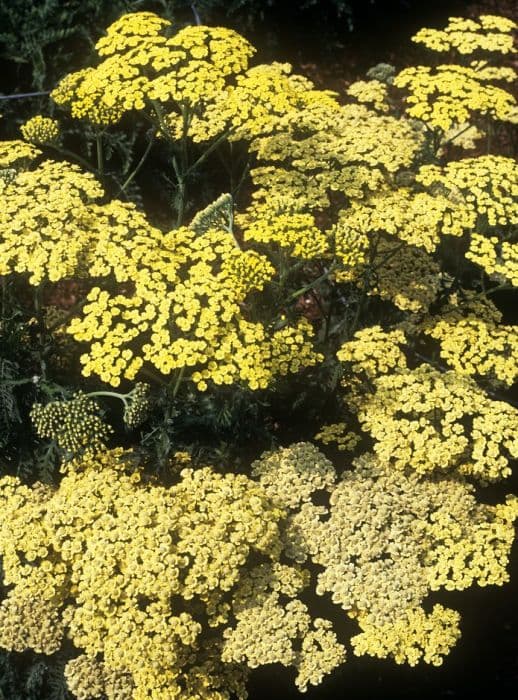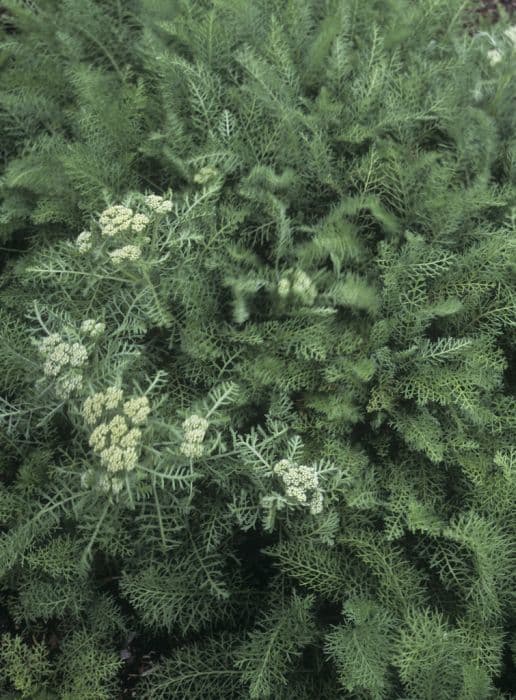Chrysanthemum Chrysanthemum 'Prelude Autumn Bronze' (Poppins Series)

ABOUT
The Chrysanthemum 'Prelude Autumn Bronze' from the Poppins Series is an ornamental plant that boasts vibrant autumnal hues. Its appearance is characterized by a profusion of flowers that have a distinctive bronze shade, mingling rich golden and orange tones mimicking the warm palette of fall. The blossoms themselves are composed of numerous delicate petals that radiate from the center, creating semi-double blooms that impart a sense of fullness and soft texture. The foliage of the Chrysanthemum 'Prelude Autumn Bronze' contrasts with the bright flowers, presenting as a deep green which underlines the plant’s floral display. The leaves are typically lobed or deeply divided, lending a lush backdrop to the colorful flowers. These chrysanthemums often form a rounded, bushy habit, with stems branching out to support the generous amount of flower heads which tend to bloom simultaneously, turning the plant into a spectacular showcase of autumn coloration. Their striking appearance makes them a favorite for garden displays, container planting, or as cut flowers to bring the essence of fall indoors.
About this plant
 Names
NamesFamily
Asteraceae
Synonyms
Hardy Chrysanthemum, Garden Mum, Florist's Chrysanthemum
Common names
Chrysanthemum 'Prelude Autumn Bronze' (Poppins Series)
 Toxicity
ToxicityTo humans
Chrysanthemum, generally considered to have low toxicity to humans, can cause dermatitis or skin irritation upon contact with its sap. Ingesting chrysanthemums may lead to gastrointestinal upset, including nausea, vomiting, diarrhea, and salivation. In rare cases, ingestion might result in more severe reactions such as allergic responses.
To pets
Chrysanthemum is toxic to pets, particularly dogs and cats. Symptoms of chrysanthemum poisoning in pets may include vomiting, diarrhea, hypersalivation, incoordination, and dermatitis. In severe cases, ingestion could lead to depression and lethargy. If a pet shows signs of chrysanthemum poisoning, immediate veterinary care is recommended.
 Characteristics
CharacteristicsLife cycle
Perennials
Foliage type
Deciduous
Color of leaves
Green
Flower color
Bronze
Height
1-2 feet (30-60 cm)
Spread
1-2 feet (30-60 cm)
Plant type
Herb
Hardiness zones
5
Native area
Asia
Benefits
 General Benefits
General Benefits- Attractive blooms: Features vibrant, bronze-colored flowers that add color and visual interest to gardens and landscapes.
- Extended flowering period: Blooms from late summer into the fall, providing long-lasting floral displays.
- Drought tolerance: Once established, it can withstand periods of low water, making it suitable for xeriscaping or drought-prone areas.
- Low maintenance: Requires minimal care once established, making it ideal for busy gardeners or those looking for low-effort landscaping options.
- Cold hardy: Capable of surviving colder temperatures, which makes it suitable for planting in various climates.
- Pest resistance: Exhibits a natural resistance to many common garden pests, reducing the need for chemical treatments.
- Attracts pollinators: Invites beneficial insects like bees and butterflies, promoting a healthy and vibrant ecosystem in the garden.
 Medical Properties
Medical PropertiesThis plant is not used for medical purposes.
 Air-purifying Qualities
Air-purifying QualitiesThis plant is not specifically known for air purifying qualities.
 Other Uses
Other Uses- Photography Prop: Chrysanthemums are often used by photographers as a colorful, textured backdrop for autumnal photo shoots.
- Art Inspiration: Artists can use the intricate forms and color patterns of Chrysanthemums as a subject for paintings, drawings or textile designs.
- Education: Chrysanthemums can be used in educational settings to teach about plant biology, hybridization, and the life cycle of perennials.
- Companion Planting: These plants may be used in gardens to benefit other plants by attracting beneficial insects or as part of a pest management system.
- Festive Decor: Chrysanthemums are used to create festive decorations for events such as fall festivals and Thanksgiving celebrations.
- Culinary Presentation: Although not consumed, Chrysanthemums can be used as a non-toxic garnish to embellish plates in fine dining.
- Color Dye: The petals can be used to create natural dyes for fabrics, yarns, or crafting materials.
- Floral Crafts: The flowers can be dried and used in potpourri, wreaths, or other dried flower arrangements.
- Symbolic Gift: In some cultures, Chrysanthemums are given as gifts to symbolize loyalty and honesty.
- Perfumery: While not a traditional use, Chrysanthemum scents could potentially be captured and used in custom perfumery.
Interesting Facts
 Feng Shui
Feng ShuiThe Chrysanthemum is often used in Feng Shui to attract positive energy and promote happiness. Place in areas where you wish to boost energy, such as living rooms or home offices, but avoid bedrooms as the strong Yang energy can disrupt sleep.
 Zodiac Sign Compitability
Zodiac Sign CompitabilityThe Chrysanthemum is not used in astrology practice.
 Plant Symbolism
Plant Symbolism- Longevity and Immortality: Chrysanthemums, in general, symbolize a long life and the immortality of the soul. They are often associated with a life of ease and longevity in many cultures, particularly in Asia.
- Rebirth and Renewal: The blooming of chrysanthemums in autumn, when many other flowers are fading, represents the idea of rebirth and the renewal of life.
- Nobility: In some traditions, particularly in Japan, the chrysanthemum is a symbol of royalty and the imperial family, representing perfection and nobility.
- Joy and Optimism: The bright and cheerful appearance of the chrysanthemum signifies happiness and positivity, symbolizing an optimistic outlook on life.
- Love and Loyalty: Giving chrysanthemums to someone can convey deep love and loyalty, representing the belief that the recipient is a valued and integral part of the giver's life.
- Overcoming Adversity: The chrysanthemum’s ability to bloom boldly as summer turns to fall is often seen as a metaphor for withstanding challenges and blossoming despite life's hardships.
 Water
WaterMum plants like the 'Prelude Autumn Bronze' should be watered thoroughly whenever the soil surface feels dry to the touch; usually, this might be once a week, but it can vary depending on the weather and soil conditions. Provide enough water to soak the root zone, which could be approximately one gallon for an established plant in the garden. During hot and dry spells, they may need water more frequently to prevent wilting. Mums in containers may require daily watering, especially in hot weather. It's important not to overwater, as this can lead to root rot.
 Light
LightMums, including 'Prelude Autumn Bronze', thrive best in full sun, which means they should receive at least 6 hours of direct sunlight daily. An ideal spot would be one that's bright and receives consistent, direct light, as this promotes strong growth and optimal flowering. However, in regions with intense summer heat, some afternoon shade can be beneficial to prevent the blooms from fading too quickly.
 Temperature
TemperatureMums, such as the 'Prelude Autumn Bronze', prefer moderate temperatures and can typically survive in temperatures ranging from 32 degrees Fahrenheit to 90 degrees Fahrenheit. Ideal growing conditions usually fall within 70 to 75 degrees Fahrenheit. They are frost-tolerant and can survive a light frost, but prolonged exposure to temperatures below freezing will damage the plant.
 Pruning
PruningPruning mums, such as 'Prelude Autumn Bronze', encourages bushier growth and more blooms. Pinch back the growing tips when new growth has reached about 5 inches in the spring, and continue doing so every two to three weeks until midsummer. This helps to create a more compact plant with more flowers. Pruning should not be done late in the season as it can impede the formation of flower buds.
 Cleaning
CleaningAs needed
 Soil
SoilHardy mums like Chrysanthemum 'Prelude Autumn Bronze' thrive best in well-draining soil enriched with organic matter. A recipe for an ideal soil mix would be to blend two parts peat moss or coco coir, one part perlite, and one part compost or aged manure. This ensures both good drainage and fertility. Additionally, they prefer a slightly acidic to neutral soil pH, around 6.0 to 6.7.
 Repotting
RepottingHardy mums, including Chrysanthemum 'Prelude Autumn Bronze,' should ideally be repotted every one to two years to replenish the soil and provide room for growth. Best practice is to repot in the spring before new growth begins, allowing the plant to establish in the new soil before the growing season.
 Humidity & Misting
Humidity & MistingChrysanthemum 'Prelude Autumn Bronze' prefers moderate humidity levels. Aim for a humidity level around 40-60% which is typical of indoor environments. Avoid placing them in exceptionally dry or overly humid areas as both extremes can cause stress to the plant.
 Suitable locations
Suitable locationsIndoor
Provide bright light, moderate water, and fertilize regularly.
Outdoor
Plant in well-drained soil, full sun to partial shade.
Hardiness zone
5-9 USDA
 Life cycle
Life cycleChrysanthemum 'Prelude Autumn Bronze' begins its life cycle as a seed, which germinates in warm, well-drained soil, typically in the spring. The seedling emerges and develops into a vegetative stage, characterized by the growth of leaves and stems, establishing a solid root system during this period. As it enters the flowering stage in late summer to fall, the plant produces an abundance of bronze-colored flowers, attracting pollinators such as bees and butterflies. After pollination, the flowers may produce seeds that can be dispersed to grow new plants. In climates with frost, the plant may die back to the ground in winter, but it is capable of regrowth from its root system if it is a hardy variety or if its roots are protected from freezing. The plant continues its life cycle yearly, with some varieties able to survive multiple seasons as perennials, while others are treated as annuals and re-planted each year.
 Propogation
PropogationPropogation time
Spring-Early Summer
Chrysanthemum 'Prelude Autumn Bronze', commonly known as mum, is typically propagated through stem cuttings, which is the most popular method for this plant due to its simplicity and effectiveness. To propagate mums using stem cuttings, the best time to do so is in the spring when the plant's growth is most vigorous. A healthy non-flowering shoot about 2 to 3 inches (5 to 7.5 cm) long should be selected and cut just below a leaf node. The lower leaves are removed, and the cutting may be dipped in rooting hormone to encourage root development. The prepared cutting is then inserted into a moist potting mix or a propagation tray. It is important to maintain consistent moisture and provide a warm environment with indirect light until the cuttings root. This process generally takes a few weeks, after which the young plants can be transplanted to their final location.









